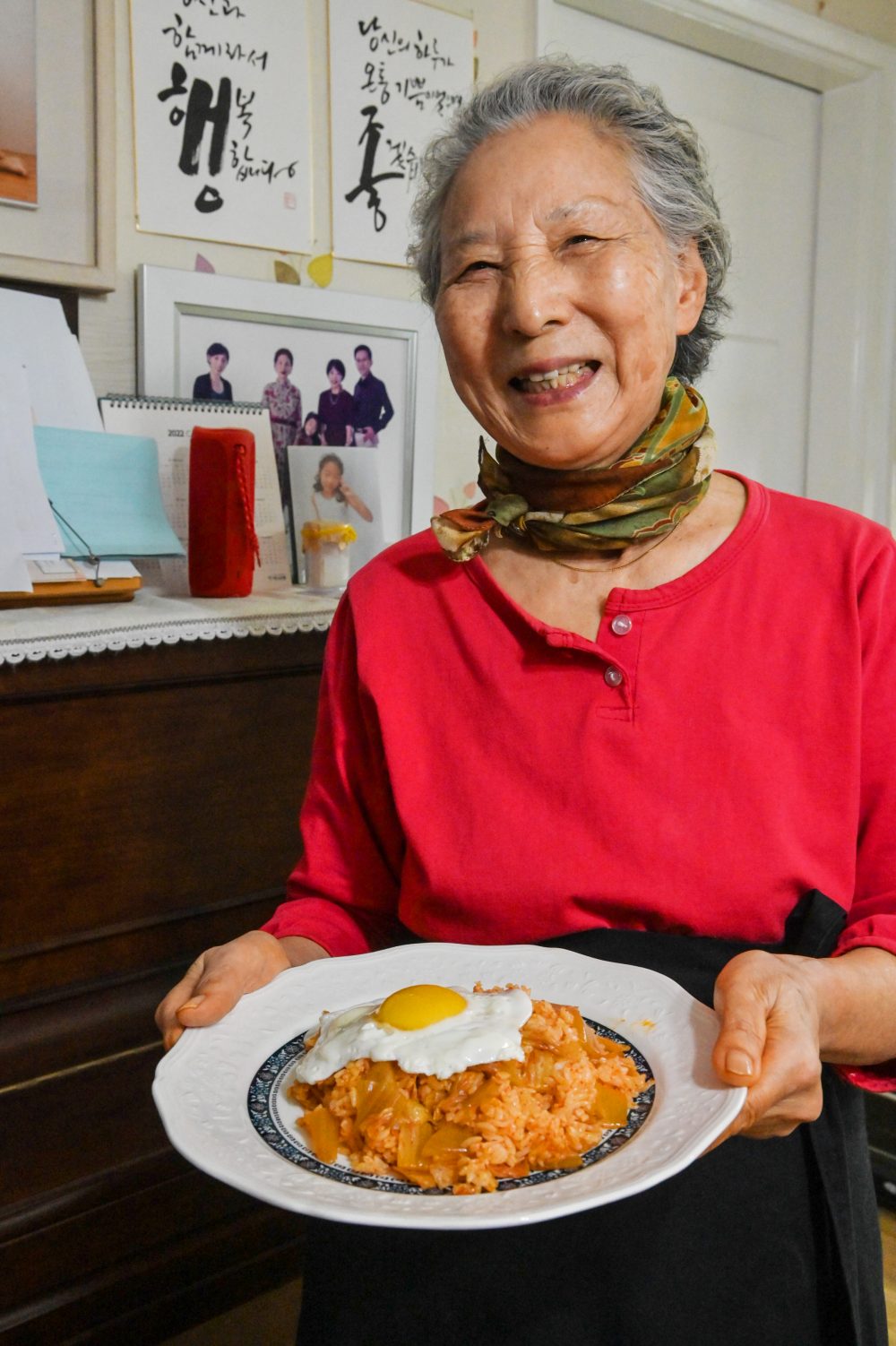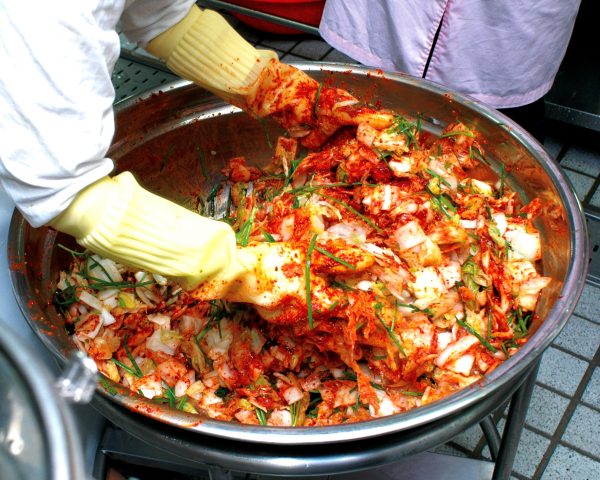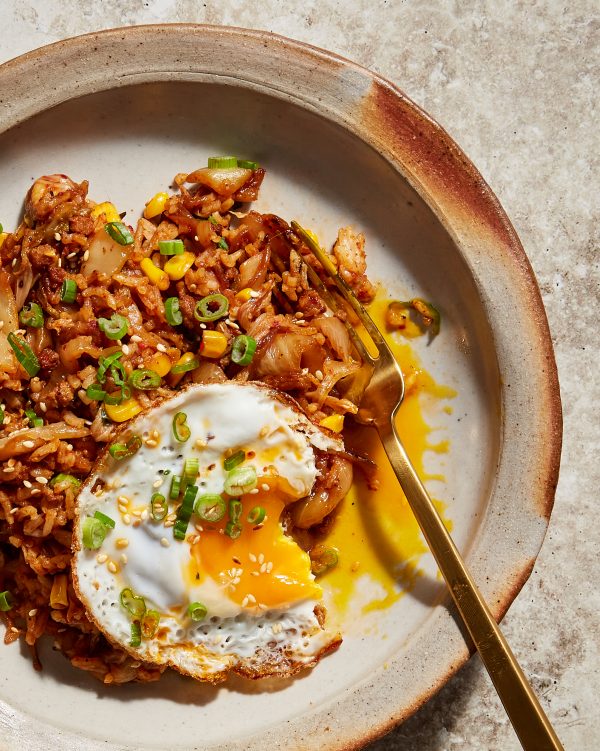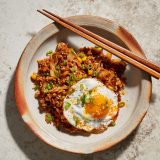
Much beyond scrambled eggs and maybe salted-and-seared steaks, two-ingredient recipes leave me suspicious. Sure, they can work, it’s just very unlikely.
Said the guy who never had been a Korean grandmother’s guest and been told to—and I am paraphrasing here—shut up, sit down and eat a plate of kimchi fried rice.
But there I was in Lee Geumja’s apartment in Hongje-dong, a neighborhood on the northern outskirts of Seoul. “It’s kimchi fried rice, so I’m only going to add kimchi and rice,” she told me matter-of-factly. Hard to argue when the ingredient list is the recipe’s name.
Her method was simple. She chopped a mound of 2-year-old cabbage kimchi, then added it and some of the fiery sauce clinging to it to a dry nonstick skillet. It cooked a bit, then she added a bit more. The goal: Some would be cooked more, some less. Some tender, some crisp.
She then added an equal amount of freshly cooked white rice. Minutes later, it was mounded on a plate, tinted red, tasting savory, sweet and spicy, and studded with cabbage.
Almost ridiculously simple. But hardly plain. And easily something I would eagerly tuck into any night, even having seconds. More importantly, it set me on a search for a crave-worthy version to bring home.
Kimchi fried rice is South Korean comfort food. And as I would learn, it can be as simple as Lee’s two-ingredient solution, or deliciously larded up with just about anything.

At markets across Seoul, spicy cabbage kimchi is made in massive batches.
But first a kimchi primer. Because that’s the real reason this fried rice works. Kimchi is ubiquitous on the Korean table, a slaw-like side dish of salted and fermented vegetables seasoned with gochugaru (Korean chili powder), garlic and ginger, among other robust flavors.
Kimchi comes in hundreds of varieties, often sold from giant tubs in sprawling markets. In the U.S., baechu-kimchi is most common, made mostly from napa cabbage. The base of the leaves remain crunchy, while the ends become tender, almost juicy with seasonings.
Most importantly, kimchi is a flavor powerhouse. Thanks to fermentation, it’s a one-stop source for salty, sweet, savory and spicy. Plus, it’s a vegetable. All of which means you really can do as little as stir-fry it with some rice and end up with an incredible meal.
But why stop there? At Chaeum restaurant in Seoul’s boutique-centric Jung-gu district, cook Choi Dong Mae prepared a more elaborate version. She started with oil in a blazing-hot wok, then added scallions, onions, green bell peppers, finely chopped carrots, ham and kimchi, all stir-fried just long enough to get a bit of color.
Next, she added corn, rice—once again, freshly cooked, but more on that later—chili oil, sesame oil and a curious red paste. In moments, it was plated and topped with a fried egg and sesame seeds. The flavor was, well ... everything! Spicy, sweet, savory, chewy, crunchy and overall amazing.
Part of the magic was that red paste, called dadaegi. Essentially, it’s a chili paste, the ingredients of which can vary depending on how you intend to use it. Choi’s involved a litany of potent ingredients, including daikon, apple, Asian pear, gochugaru, garlic and ginger.
To make sense of these different takes on the same dish, I turned to professionally trained home cook Sung Min Lee. He agreed that only rice and kimchi are essential. But also that they are just the start.
Kimchi fried rice is peasant food, he explained. It’s all about leftovers. You start with kimchi and rice, then add whatever you have. The version he made used leftover spicy stir-fried pork his mother-in-law had made. It was terrific.
But about that rice! It was new to me to use freshly cooked rice. Most fried rice traditions call for using chilled leftover rice, which resists clumping and stays lighter. Indeed, every kimchi fried rice I tasted had a more glutinous texture than I was used to.
As we developed our recipe, we borrowed lessons from each of the cooks. We loved Lee’s simplicity. We also loved Choi’s dadaegi. And Sung’s mother-in-law’s leftover pork? We tried to draw in that, too.
Where we veered from tradition was the rice. I’d gladly eat versions made with freshly cooked rice, but we preferred the texture of leftover. And it seemed in keeping with the spirit of Sung’s recipe.

Spicy-savory kimchi fried rice is best topped with a runny fried egg.
Related Recipes
May - June 2023

Sign up to receive texts
Successfully signed up to receive texts!
We'll only send our very best offers - Like a $15 store credit to start.
By entering your phone number and submitting this form, you consent to receive marketing text messages (such as promotion codes and cart reminders) from Christopher Kimball's Milk Street at the number provided, including messages sent by autodialer. Consent is not a condition of any purchase. Message and data rates may apply. Message frequency varies. You can unsubscribe at any time by replying STOP or clicking the unsubscribe link (where available) in one of our messages. View our Privacy Policy and Terms of Service.







